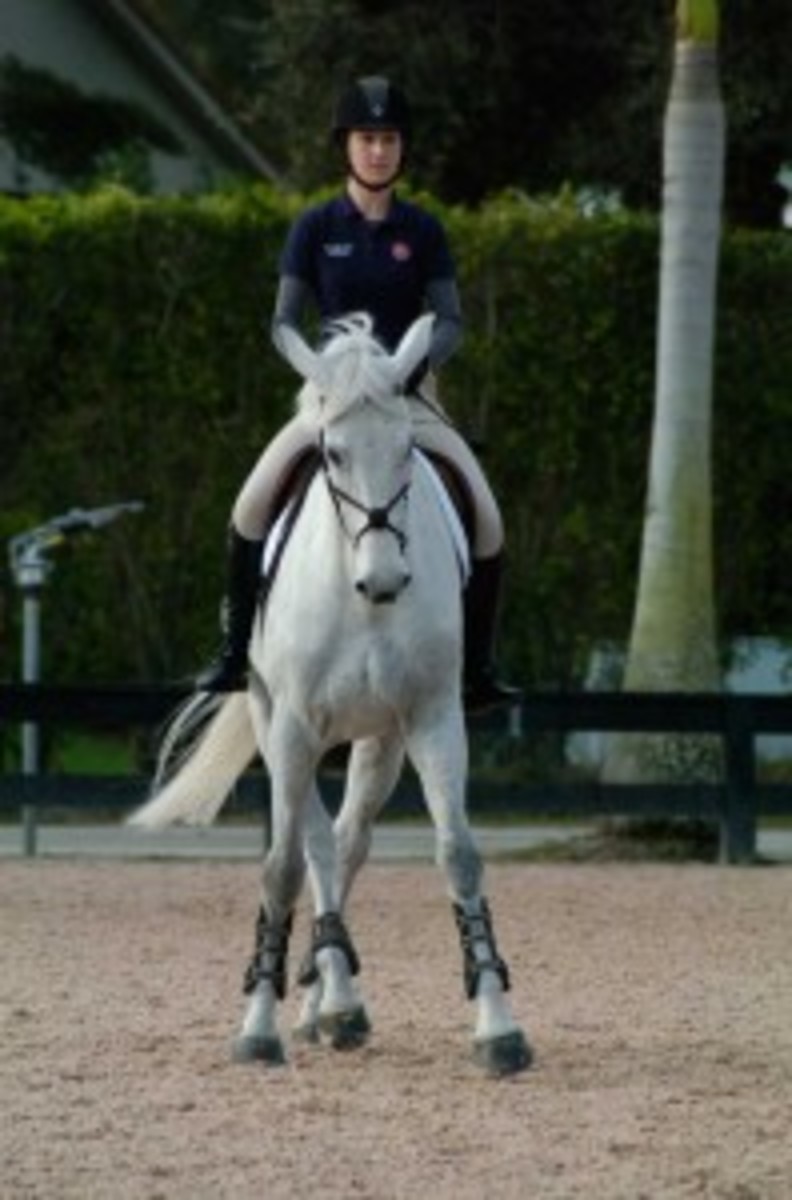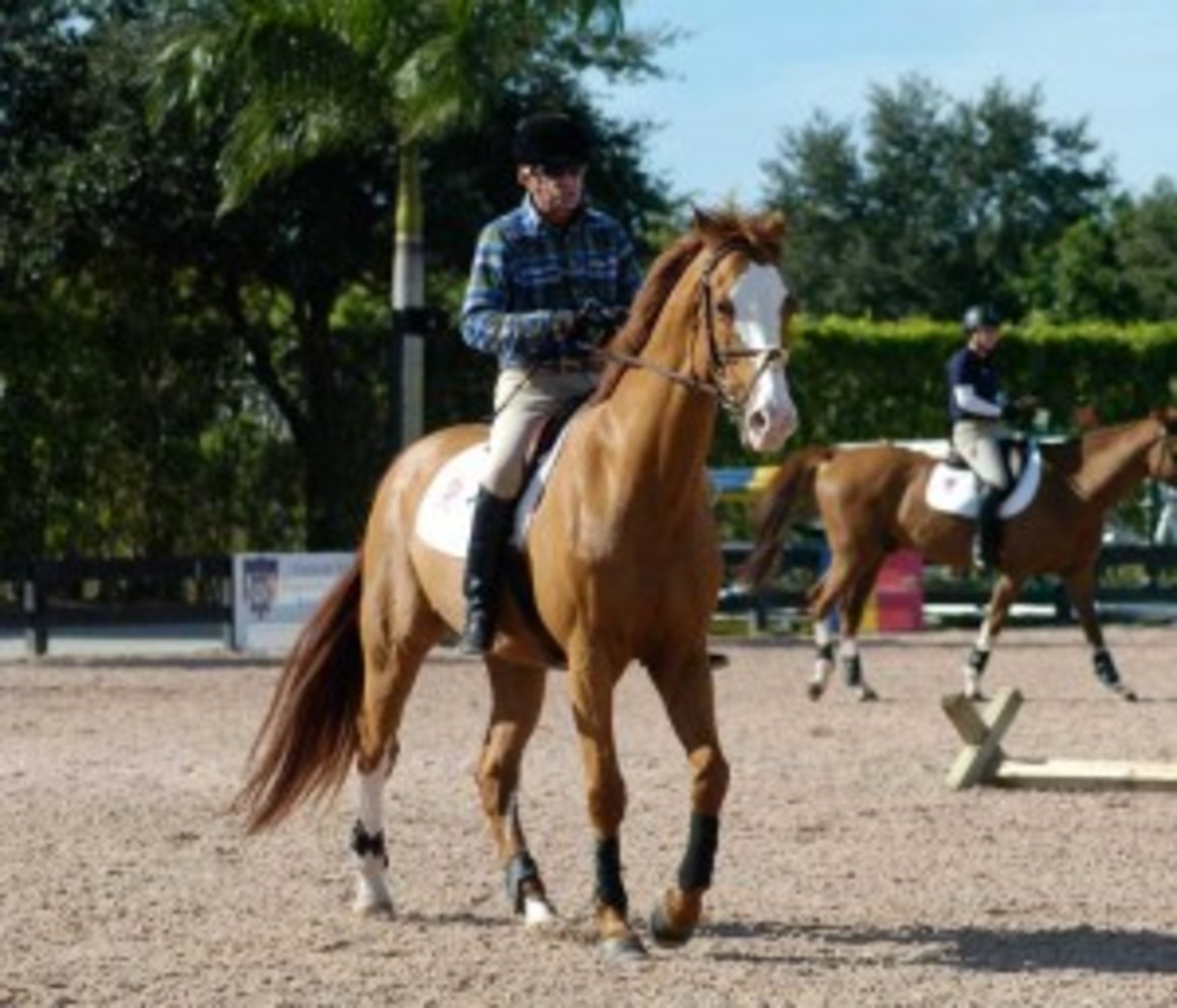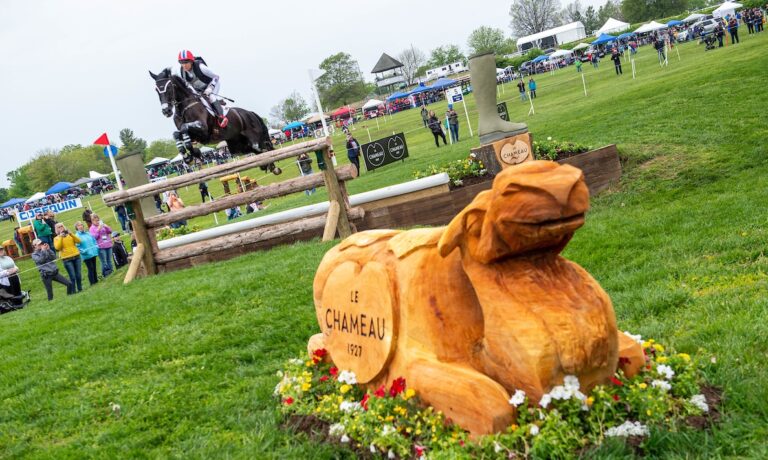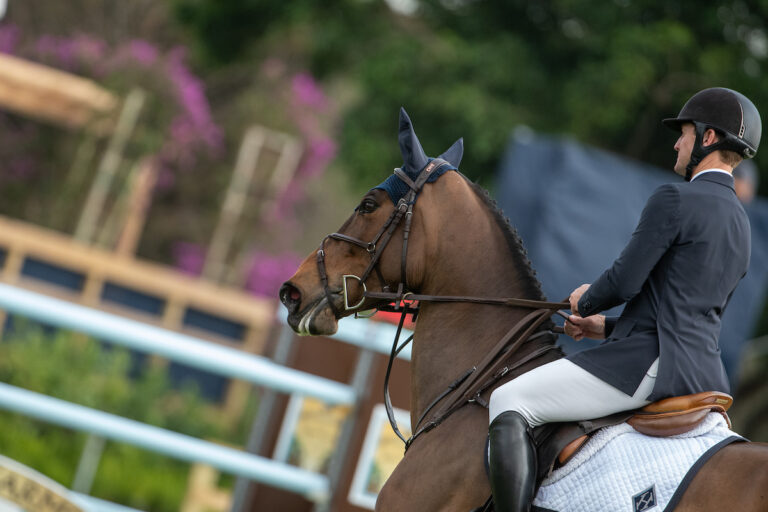January 3, 2014?Though the young riders worked on the flat without stirrups on the fourth day of the George H. Morris Horsemastership Training Session, the Olympian and former U.S. team coach didn’t relent in his quest for correct forward riding.

The 12 riders were selected for the comprehensive five-day training program in Wellington, Florida, based on their performances in equitation, jumper and hunter competitions throughout 2013. The goal of the program, which encompasses mounted sessions as well as stable management and veterinary and farrier care, is to develop a pipeline of young ?horsemasters? for future U.S. Equestrian Teams. The lessons, however, are important for horsemen of all levels and ages.
At the start of today?s two riding sessions, George explained that riding without stirrups improves the rider?s tightness on a horse and helps a rider maintain balance. ?It vastly and quickly gives you feel,? he said because you sit very deeply. He rides without stirrups once a week ?because it makes me part of my horse.?
Riders in the two morning sessions started out walking on a large circle. There George reminded them that he first wanted to horses to be in front of the leg, straight from the inside leg to the outside rein.
He wasn?t concerned if the horses started out with their heads up in the air. He reminded some of the riders to keep their thumbs up and their hands lifted, especially if the horses raised their heads. ?If the horse resists the bit, I don’t drop my hand down. I keep it there and close my fingers. The horse has to accept the hands.?
He reiterated this point several times throughout the first and second sessions. ?You don’t pull the head with the hand, people. You ask the hind leg of the horse to come under him. That’s called engagement.”
?The hind leg is where is starts,? he added, saying it comes forward and under the horse’s body. You break up any resistance the horse has by getting his hind legs active. When that happens, the croup starts to drop. Then the base of the neck, where it attaches to the shoulder, comes up. As a consequence, the horse’s head will drop down and he will start to round.
?No thinking of pulling the head down,? he said several times during the morning.
George then had the riders work on some walk?halt transitions, using four parts of their bodies to ask for the halt: back, seat, legs and hands. He told them to stretch in their spines, which gives a rider power, keep their legs on and close their hands. When the horse responds, he said they should give a little with their aids.
If a horse slowed at the walk, he told the rider to touch him with the spurs to keep the horse lively so he would start to work in self-carriage.
The riders then moved on to trot work. George said they should start out in a slow sitting trot until they get their seats. He instructed them to sit to the front of the saddle, as close to the pommel as possible, so they were over the stronger shoulder area of the horse, not the weaker bridge area of the loin. This position drives the riders? knees down. The legs then stay on the horse’s rib cage and in contact with his sides, which helps to control his hindquarters.
As riders worked on smaller circles, George reminded them that the topline of the horse is bent around the inside leg in accordance with the bend of the circle. After a few circles, he had the riders go straight and a little forward to improve the impulsion.
The first group of riders next trotted over a serpentine pattern of three single cavalletti. (The second group did the same work but after they had done the lateral work.) As with yesterday?s work over cavalletti, the focus was on rhythm. The right and left turns over them helped the horses become more comfortable stepping over small obstacles. The second group also incorporated a line of two cavalletti with two steps between them.

As the riders looped over the cavalletti, George said ?this is playing with your horse.? He loves watching riders like Germany?s Olympic gold medalist Isabell Werth. ?She plays with her horses.?
After a few minutes over the cavalletti, he had the riders in the first session do a half-turn in reverse, starting by riding a diagonal line into the arena and then riding a half-circle, making sure the new inside leg is very definite and the outside hand has a very definite contact. With the second group of riders, he changed the exercise and had them do just a half-turn, but ride it doing a little haunches-in.
The riders then worked on shoulder-fore, in which the angle of the horse’s front end is less than 15 degrees and, from the front, you can see the horse’s inside hind leg tracking between the two front legs. If a horse started to stiffen on the inside rein, George told the riders to very delicately play on that rein.
After a few steps at shoulder-fore, riders went straight and forward for a few steps. Then they rode haunches-in and alternated between the two movements. ?Get that horse dancing behind,? George said. This type of lateral work breaks up a horse’s resistance behind so he becomes more supple, he explained.
With the second group, he discussed the half-halt a little more. He had them ride a ?big, obvious? half-halt, by stretching up in the spine, sitting a little deeper, adding leg to hand for a very brief step of walk. Then they went right back to trot. This encourages the horse to stay forward and give a little, he said.
Canter Work
In the canter work, George reminded riders that he wanted them to use their inside legs to outside reins with a slight flexion of the head to the inside. ?That’s ALL,? he said. He didn’t want the horses bent.
The riders worked on canter?trot transitions, cantering for eight to 10 strides and trotting for five strides and making sure that the first trot step was active. George wanted them to focus on the three-beat rhythm of the canter and the two-beat rhythm of the trot. ?it’s a question of the canter rhythm and the trot rhythm, not just the transition.?
In the second session, he had the riders work on shoulder-fore at the canter for a few steps, and then go straight. The exercise is very hard on the horse, he cautioned, so riders should do them only minimally.
George then had the riders do one of his favorite exercises in the canter:
Ride a half-turn and maintain the counter canter. He likes it because it collects and balances the canter. So riders on the right lead rode a half-circle so they were traveling to the left still on the right lead. The outside left leg needed to be behind the girth regulating pace, the critical inside leg was ?stuck to the girth? and the inside right rein played, giving and taking, relaxing when the horse softened in the jaw. ?That inside rein is desperate to give,? George said.
Riders made a few of these half-turns, maintaining the counter canter. The work also helped the horses start to be in self-carriage. ?Self-carriage is where a horse holds himself, maintaining his own balance and impulsion,? George explained.
Next, the riders worked on canter?trot transitions. As with the trot?walk transitions, they needed to stretch up in their spines and sit, closing the outside hand. In the canter, ?I want you to be obsessive with this inside leg and outside rein,? George reminded them.

Riders then worked on changing directions and incorporating flying changes into the work. George reminded them to sit back a little in the turn and make sure they straightened the horses from the inside leg to outside rein before changing aids to ask for the change. He wanted the horse to make the changes exclusively from the riders? leg aids. ?it’s cheating if you use your hands,? he said.
More transitions were next, but this time it was within the canter. George instructed the riders to go straight and lengthen the canter for 10 strides and shorten it for 10 strides. To lengthen, they just needed to relax with the hand because the horses were already traveling with impulsion. In the collection, ?I want to see how slow they?ll go.? If the horse fights the bit, ?we close our fingers. We don’t surrender and drop our hand.?
To finish the riding session, George had the riders return to trot and progressively lengthen the rein, going long and low, which is how he finishes riding jumping horses. But they still needed to maintain their horses? impulsion. If the horse slowed, he told them to touch the horse with the spur to remind him to go forward. He had them do the same at the walk.
George Rides
Near the end of the second session, George rode Samantha Harrison?s horse, a chestnut with a big white blaze, whom she had not ridden in the training session before. He pointed out that the horse’s conformation made it easy for him to put his head up.

As he walked the horse, he said that the position of the head and neck of the horse is obvious because you can see it, which is why so many people focus on it. But roundness begins with a horse’s hind end.
To ask a horse to round, George uses an ?old-fashioned French system with my hands. I show [the horse] an early lesson that he can’t get his head higher than my hand. ? I’m keeping my hand up and driving him forward with my inside leg, very much on the outside rein. When He’s in a beautiful place, with his neck arched and round, I soften and lower my hand. I teach a horse quickly how to lower his head.? He pointed out that he doesn’t use gadgets like draw reins or tougher bits.
When the horse relaxed and softened in the jaw, George lowered his hands a little and relaxed his leg. When the horse raised his head, George?s hands went up a little, he closed his fingers and he pushed with his legs. ?You won?t see me sawing on the horse’s mouth,? he added.
Using the same principles, he rode shoulder-fore and haunches-in at the walk and moved on to walk-trot transitions making sure to keep his chest up, his back braced a little and his lower back (near the belt) slightly hollow.

When he moved on to the cavalletti, he asked whether the horse would go over them nicely or leap. ?When I yield, will he hold himself? Will self-preservation back him up.?
George also worked at the canter and on flying changes. The horse could make the changes from left to right, but had more trouble trying to change from right to left. As George asked for that change, he maintained his position and patiently kept asking with quiet aids, saying, ?My horses are my babies.? He explained that the horse didn’t understand the right-to-left change. ?He gets it, but he freaks out a little and swaps back,? he said. ?But he did it. I’m happy he did it.
As he had with his students, George finished the session on a long rein at the walk, making sure to use a little spur if the horse fell behind his leg. The horse’s ears were pricked forward and he had a relaxed look to his eyes. ?The horse is very content,? he said. ?He’s physically and mentally submissive.?
The George H. Morris Horsemastership Training Session is presented by the U.S. Hunter Jumper Association and supported by the U.S. Equestrian Federation, the U.S. Equestrian Team Foundation, Practical Horseman and the Winter Equestrian Festival.
To watch the riding sessions live or on demand, go to www.usefnetwork.com.










